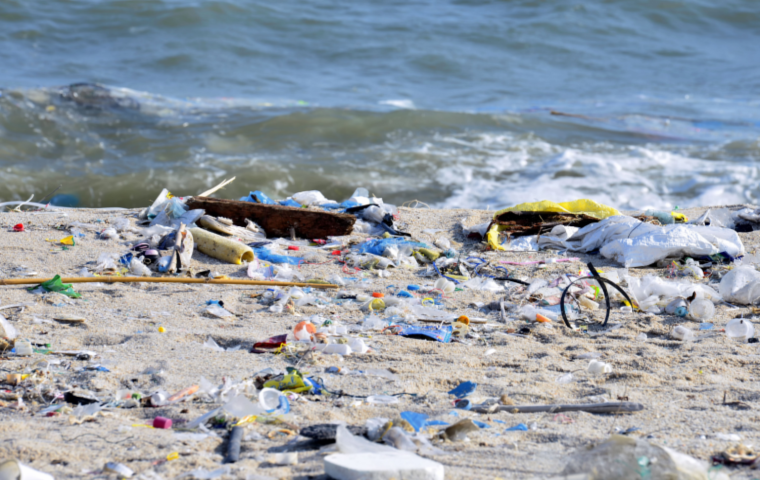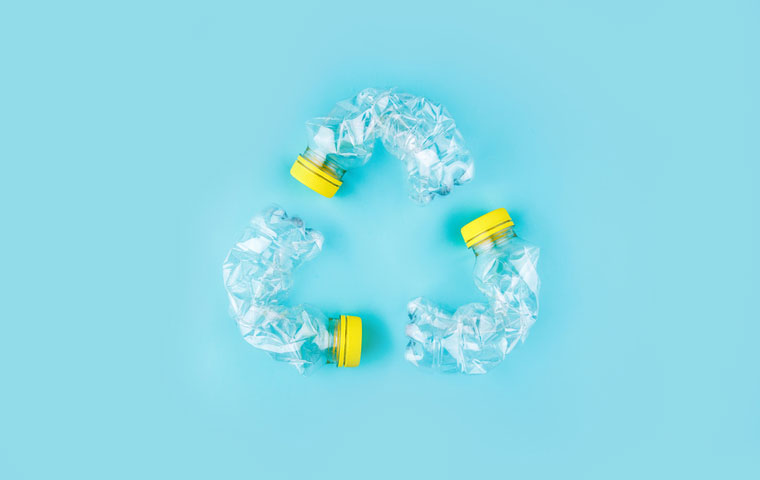Japan Works on Treaty towards Ending Plastic Pollution
Related Articles

“I grew up with the sea, and poverty for me was sumptuous; then I lost the sea and found all luxuries grey and poverty unbearable.” As Albert Camus wrote in an essay, the ocean is the enriching source of our lives. Both the French words mer (sea) and mère (mother) being the same-sounding feminine nouns remind us that life on earth began in the ocean in prehistoric times. With a volume of approximately 1.37 billion km3 of water and covering over 70 percent of the earth, the ocean plays an immeasurable role for every living thing on the planet. Sir Arthur C. Clarke is said to have remarked, “How inappropriate to call this planet Earth, when it is clearly Ocean,”—vividly depicting the ocean’s commanding presence. As the eighth most island-rich nation in the world, Japan has developed close relations with the ocean from ancient times, including through seafood and other blessings of the ocean and maritime logistics. Even in Yokohama City, there are several shell middens, inland from my home.
Asia the Main Origin of the Spreading Plastic Pollution
Now, the ocean is on the verge of crisis—with rising sea levels and temperature mainly from global warming, the resulting loss of biodiversity, and pollution by oil and chemical spills from vessels.
In particular, the seriousness of plastic pollution is causing increased concern in recent years. Plastic continues to exist without returning to nature, and once it drifts out into the ocean, recovery is barely feasible. Plastic is a cheap, durable, and convenient material. With expanding usage and increasing demand, its production has been continuing to rise steadily. As if following this trend, marine plastic pollution is escalating. According to the 2016 report released by the World Economic Forum and the Ellen MacArthur Foundation, weight-wise, the ocean may contain more plastic than fish by 2050. The increasing plastic waste is causing various problems, such as deteriorating ecosystems and other marine environments, reducing coastal functions, ruining the landscape, obstructing vessel navigation, and affecting fisheries and tourism. Also, in recent years, the impact of microplastics (plastics smaller than 5 mm) on marine ecosystems has become a matter of concern and global urgency.
Where does marine plastic litter come from, and how does it end up in the ocean? Although there are no established universal statistics yet, according to a 2015 estimate by Dr. Jenna Jambeck et al., eight countries, including China and Southeast Asian and South Asian nations, are among the top 10 emitters of marine plastic litter (see figure below). The report argues that the high-ranking countries lack adequate waste management. At places without established waste collection systems, plastic waste, whether from businesses or households, either remains scattered on the streets without being collected, is taken to dumps, or collectively put in landfills. Plastics included in such wastes end up in the ocean by flowing out from rivers.

Since marine plastic litter drifts around the world regardless of borders, firm determination and cooperation among the world’s countries are essential to solve this problem. Amid mounting global concern to address plastic waste, more effective measures are crucial.
Japan’s Efforts towards a New Treaty
With widespread concern about plastic pollution at home and abroad, at the 2019 G20 Osaka Summit, Japan announced the Osaka Blue Ocean Vision that aims to reduce additional pollution by marine plastic litter to zero by 2050. On the premise that plastics are useful, the vision seeks the involvement of many countries including large emitters of plastics. So far, 87 countries and regions have shared this vision.
Toward realization of the Osaka Blue Ocean Vision, Japan launched the MARINE Initiative, which focuses on (1) Management of waste, (2) Recovery of marine litter, (3) Innovation, and (4) Empowerment to advance effective global actions to combat marine plastic litter. As of August 2022, under the initiative, Japan has trained over 17,000 personnel in waste management in developing countries.
Through system design, installing high-quality environmental infrastructure, and support for new technology introduction, Japan has also contributed to steadily reducing marine plastic litter by meeting the needs and circumstances of each country. For example, Japan has implemented a project in Southeast Asian countries using Japanese start-up technology to monitor plastic waste flowing into rivers, with AI detecting the “hot spot” of discharge. Based on scientific findings, the project contributes to effective measures against plastic pollution. Also, at the High-Level Panel for a Sustainable Ocean Economy, where Prime Minister Kishida is a member with myself serving as the Sherpa, we actively contribute to the discussions on marine conservation, including measures against marine plastic litter, while sharing information on projects in Japan.
March 2022 marked a historic moment in international efforts against plastic pollution. The United Nations Environment Assembly (UNEA), made up of the 193 UN member states, met in Nairobi, Kenya, and adopted the Resolution “End plastic pollution: Towards an international legally binding instrument.”
With regard to measures against plastic pollution, some countries seek uniform restriction including upstream measures across the globe, while others seek approaches that take into account national circumstances instead. Regarding the issue of plastic waste, some countries lack sound management of wastes and for them the imminent issue is tackling the waste piles at hand. In some other countries including Japan, waste collection systems have become part of a daily life and reuse of plastics is working. Since the situation and necessary measures vary by country, pressing forward with one-size-fits-all restriction could fail to convince the major polluters, with many being developing countries, and the treaty may only have limited signatories. With the transboundary nature of plastic pollution, for effective measures, it is vital for the entire international community to collaborate in addressing the issue.
The Japanese delegation worked hard to prepare a draft resolution agreeable by a wide range of countries, including the major plastic emitters. After many rounds of negotiations with each country, considering national circumstances, Japan proposed a draft resolution intended to address plastic pollution from a full life cycle approach that takes measures in each stage of plastic production, sales and consumption, and waste management and discharge. A resolution largely incorporating Japan’s proposal was finally adopted unanimously. The resolution established an Intergovernmental Negotiating Committee (INC) to develop an international legally binding instrument on plastic pollution, including in the marine environment, with the aim to complete treaty negotiations by 2024. Inger Andersen, Executive Director of the UN Environment Programme (UNEP) said, “This is the most significant environmental multilateral deal since the Paris Accord.” This resolution became a landmark towards solving the serious environmental problem—plastic pollution.
Approaching the Entire Life Cycle is the Key
The first session of the Intergovernmental Negotiating Committee (INC1) of an international legally binding instrument on plastic pollution took place in Punta del Este, Uruguay, in November 2022. I led the Japanese delegation to the treaty negotiations. At the INC1, many countries referred to the need to establish a common global goal that aims to protect human health, biodiversity, and the environment.
Some international environment treaties set both qualitative and quantitative goals. Since many countries have already shared the goal of reducing additional marine plastic litter to zero by 2050, under the Osaka Blue Ocean Vision, Japan is in a position to drive the negotiations based on this goal. To promote further efforts, mechanisms for countries to cooperate in strengthening scientific knowledge are also needed.
A senior official from Japan’s Ministry of Environment has been selected as a member of the Bureau (Chairs and Vice-Chairs) from the Asia-Pacific region. From the respective roles in the Bureau and the delegation, Japan intends to lead the negotiations towards an effective and progressive treaty by considering the differing situations of each country and involving the Asia-Pacific region. Plastics are inseparable from our daily lives. Considering both their usefulness and impact on the environment and discussing the specific provisions is not easy. While there is not enough scientific data regarding plastic pollution, there are various issues to be discussed, such as the definition of plastic pollution, the treatment of additives, how to guarantee each country’s efforts, and how to support countries requiring capacity building.
Domestically, Japan has already enforced the Act on Promotion of Resource Circulation for Plastics in April 2022, and is further promoting the “3R (Reduce, Reuse, Recycle) + Renewable initiative” for nation-wide efforts against plastic pollution. On the global stage, Japan will also boost the efforts for addressing the full life cycle of plastics by encouraging other nations to promote resource recycling, while continuing to provide support tailored to each country’s needs, under the initiative.
Japan holds the G7 presidency this year. As an advocate of the Osaka Blue Ocean Vision at the 2019 Osaka G20 Summit, which has led measures against marine plastic litter, Japan is determined to spearhead the discussions at the 2023 G7 Hiroshima Summit. Surrounded by the ocean, and greatly blessed with its benefits, Japan, in collaboration with the G7 and the rest of the international community, will strongly assume the role of promoting measures to end plastic pollution brought on by humans.
This is a translation of the Japanese article published in vol. 76 (Nov./Dec) of the Gaiko (Diplomacy) magazine.
Takeshi Akahori is the Assistant Minister (Ambassador) for Global Issues of the Ministry of Foreign Affairs since 2022. After graduating from the University of Tokyo, he joined the Ministry of Foreign Affairs in 1989. He has earned a Master’s degree in International Public Administration from the Ecole Nationale d’Administration (ENA) in France. He has served as a Counselor at the Embassy in Washington, DC, Director of Japan-Korea Economic Affairs concurrently with Senior Coordinator of Denuclearization of the Korean Peninsula, Director of Cultural Affairs, Executive Assistant to the Foreign Minister, Director for Treaties, Political Minister of the Permanent Mission of Japan to the UN, Secretary General of the G20 Osaka Summit, and Deputy Assistant Minister for Foreign Policy.




